get 500+ free images, templates & marketing strategies! You're one click away, Don't Miss It.
How to make a 12 month plan — Goals, Vision, and Content
This post may contain affiliate links. Please read the disclaimer

Ready to kiss this year goodbye and look ahead to the new year!? The #1 enemy of not accomplishing goals is a broken focus, so to get back on track for your new year, we need to reclaim our focus and make a plan!
Download my free Annual Planner and Yearly Journal (50 page pdf)
Why create a plan?
- Knowing you have a pathway to follow feels good
- Planning inspires action
- Setting goals makes you feel accomplished
In this post, we’re going to talk about setting goals with ease and taking inspired action for the year ahead. To do this, I recommend retreating to a quiet place and giving yourself time to really ask the big questions and ponder your big goals.
Set aside an afternoon, a day, or even a couple of days if you can!
This is your business, and it deserves attentive and focused planning to grow and evolve.
I’m going to let you in on a little biz secret — the most effective way to plan is to focus on ONE thing at a time.
Don’t dive in and scatter lists all over the table or open up a million google docs at once. When you have too many things on your plate, your focus becomes blurred. Instead, take your time and work through this process slowly.
I love this acronym…
FOCUS: Following One Course Until Success.
This acronym demonstrates how important it is to take action and follow through on each part of your business plan. The more action you take, the more progress you’ll make, and the more satisfaction you’ll feel!
The exercises I’m leading you through in this post are NOT about doing everything perfectly! We cannot let perfect action become the enemy of good action.
If the past few years have taught us anything, it’s that perfect plans aren’t always the best.
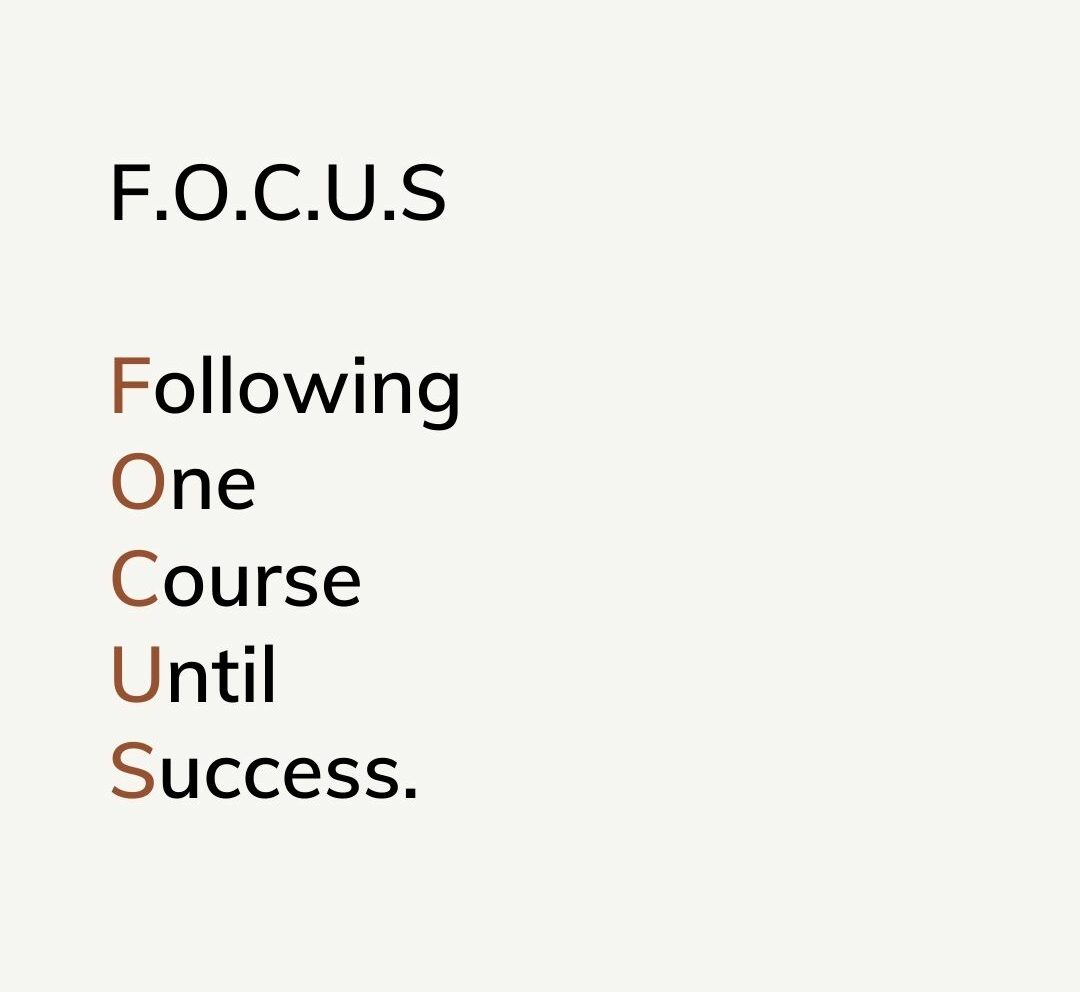
Step One – Pick Your Theme for the Year (Word/Idea for the year)
Choose a theme that will help inspire action all year long. To narrow one down, think about how you want to feel throughout the year. For example, this year my theme will be “inspired action.”
Step Two – Brainstorm How to Get There
Begin a list of ways that you can embody your chosen theme in the new year. How can you bring that theme into your life?
Use this list to invigorate yourself when you get off track.
Step Three – Set 2 to 3 BIG Goals
Now it’s time to get more specific.
If you were to accomplish something distinct in the coming year, what would make you the most excited? The proudest? What 2-3 big things will make this upcoming year feel like a success if you get close or achieve them?
Maybe it’s scaling your revenue with existing products, or creating clear boundaries in your business? Whatever the case, set goals that are a little uncomfortable but not TOO uncomfortable. The best goals are hard to reach, but not impossible.
What 2-3 goals come to mind?
Step Four – Create a “Would Be Nice” List
Brainstorm outcomes that could be easily achieved by working on them for a few days or by occasionally working them into your schedule. These would-be-nice outcomes don’t need to be major goals, but they do need to help support how you want to feel throughout the year.
An example? Maybe you want to feel more refreshed and at peace in the new year, so you choose to spend more time in nature and hike at least once a month.
Brain dump a list of “would-be-nices” like this example that will help you feel better. Go for it and list as many things as you can!
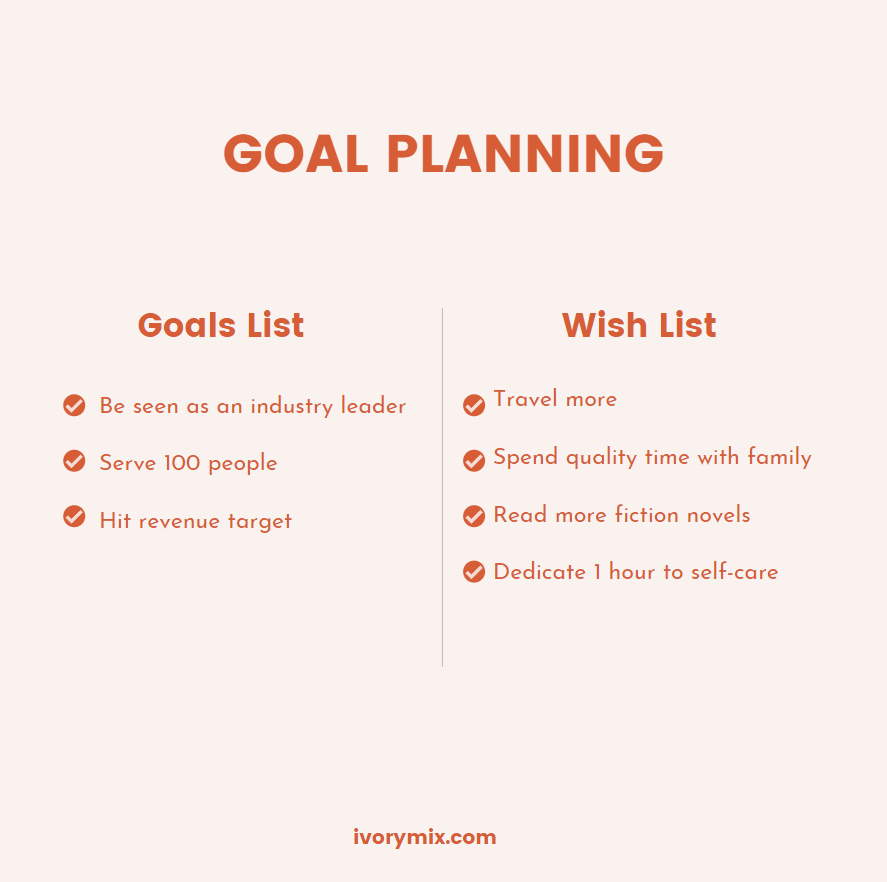
Step Five – Gather Data from the previous year
Now that you’ve set your theme, big goals, and would-be-nice ideas, it’s time to dig into the numbers to see where you have room for improvement. Open up those past year metrics and take a look! They are the key to making a plan and achieving your goals.
A quick note: Some people tend to start with the numbers and work backward. My advice is to not do that. Instead, begin with how you want to feel in the next year, like we have in the steps above, and set those intentions before you ever look at the data.
As business owners, we can easily get wrapped up in the numbers. But to be fulfilled in our lives, we need to start making decisions based on our desires.
So what do you really want from the new year?
Once you’ve decided what you want, the data will show you how to make informed decisions to get there.
Data to gather may include:
- Website analytics
- Subscriber info
- Financials
- Profit and Loss sheets
- Leads
- Sales
- Notes and Journals
Think about how much you made in the past year, how many email subscribers you added to your list, how many visits there were to your sales pages, etc. Look at where your website traffic comes from and what blog posts performed the best. Really dig in and study the metrics.
In addition, look at what you’re spending on your team, your projects, and the tools you’re paying for to see if they are accomplishing what you intended them to.
What has created success? Let this data inform your next steps.
Step Six – Ask deeper questions about your Top 4 Priorities as a Business Owner
When you peel away the outer layers, most business owners really have the same set of priorities no matter their niche. These 4 priorities need to be considered when you’re setting your goals for the coming year:
- What will increase sales?
- What will increase my social proof?
- What will improve my profitability/operations?
- What do you need to do to master your craft?
Make sure you’re revisiting these questions often to determine if your plans will help you achieve one of these four goals.
Step 7 – Set Your Specific Quarterly Goals
To help you achieve your 2-3 BIG goals, it’s time to dive into the nitty-gritty.
I like to place one “ROCK” goal on my planner per quarter. This goal is “set like a rock” and requires long-term planning, focus, and strategy. Sure, some ROCK goals may take longer than a quarter, and that’s okay, but break them down as much as you can to fit them into a smaller, more defined time frame.
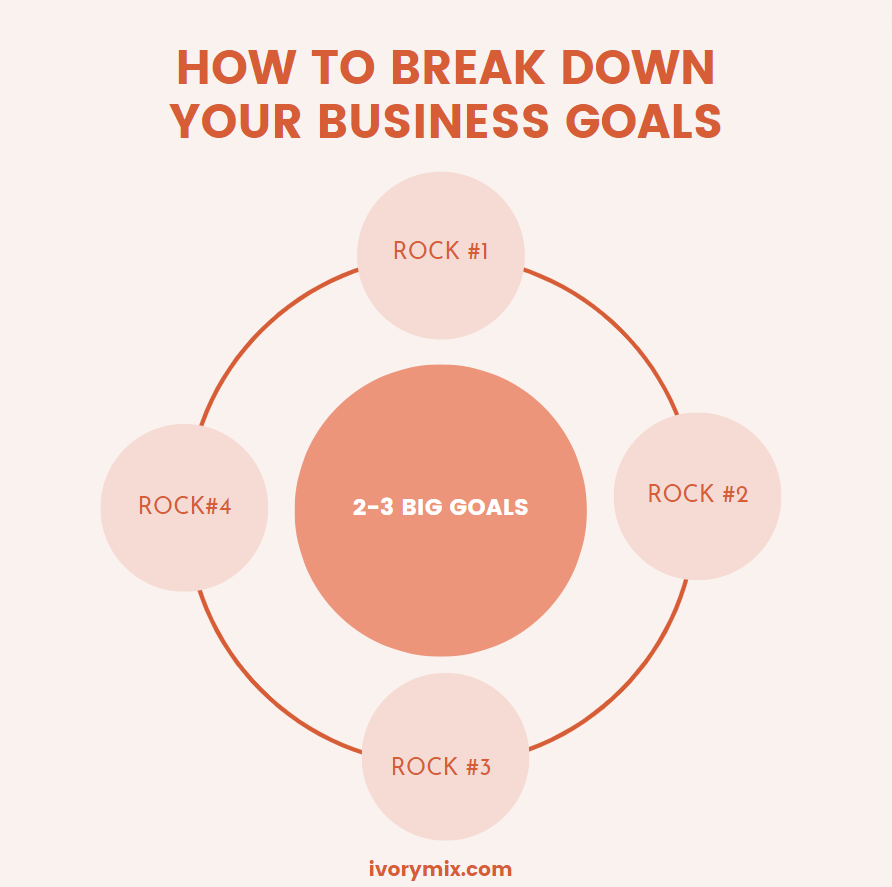
If you find you have too many goals on the calendar, be willing to cut the fat and move them to the “would be nice” list.
Then ask yourself: What should I DO, what should I DELEGATE, and what can I DELETE?
Use this method to pair down your plans into steps that you and/or your team can accomplish day in and day out.
Step 8 – Specify the details
Once you have your ROCK goals set, you need to spend time outlining the specifics and how you make these goals happen. Using Trello, Asana, or Click Up, create and schedule tasks that can be checked off when complete.
You can organize your goals and plans on a Trello board like this example here:
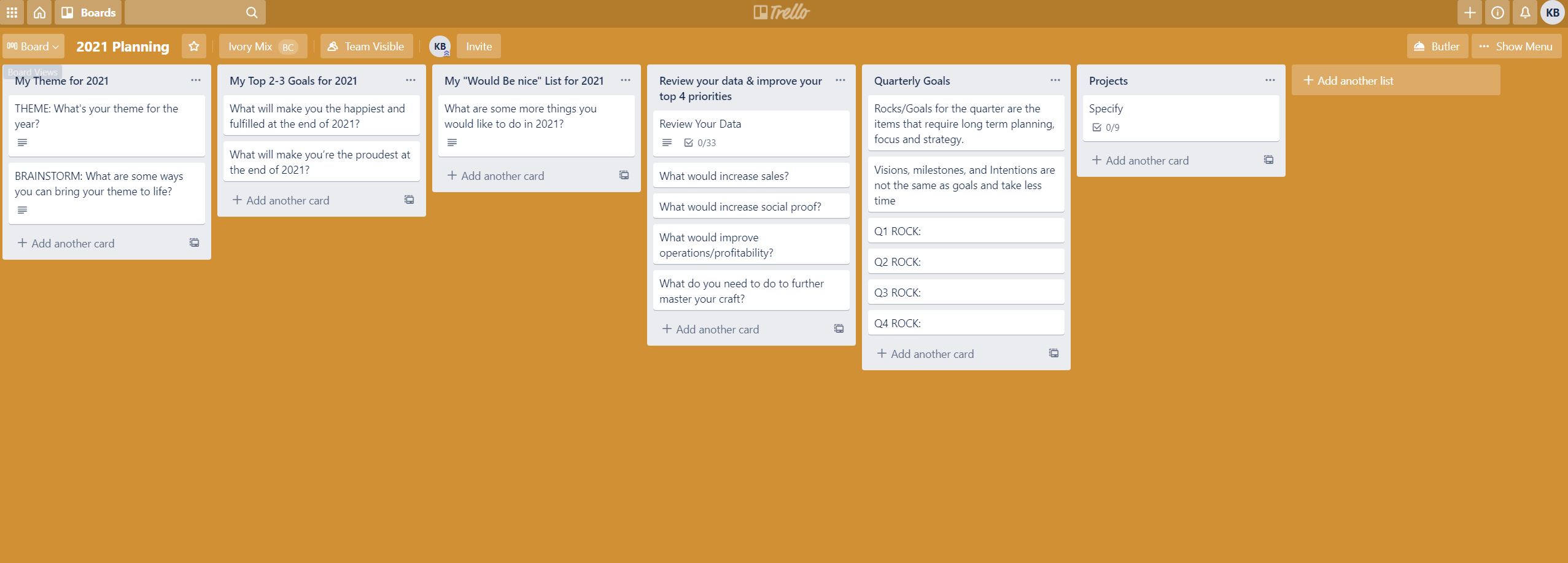
Step 9 – Gather Content Ideas
Creating supporting content is a step we can’t leave out of your new year planning! After all, your content is the key to supporting your goals. Start by brainstorming content ideas that will help you move toward success.
To get started, ask yourself :
- What does my audience struggle with?
- What do they always ask about?
- Why do they always ask about it?
- What’s missing for my audience?
You can organize your content ideas on a Trello board like this one.

Come up with themes for your audience to meet these needs and address these specific pain points. If possible, try creating quarterly content themes, then break those up into monthly themes.
Your content themes should easily relate back to your offerings, so the sales conversations can continue, and you can easily turn your audience into paying customers. If they don’t, ask why, and revisit your goals to fix that.

Step 10- Create Batch Days on Your Calendar
Batch days are ways of organizing your time by doing similar tasks on similar days. For instance, when it comes to content creation, batching may look like this:
- Monday — Draft Day. Create your outline and bullet points for blog posts, lead magnets, webinars, and Facebook Lives.
- Tuesday — Writing Day. Fill in your outlines and do the bulk of the writing for your blog, emails, webinar content, etc.
- Wednesday — Repurpose Day. Pull points from blog posts and create social content.
- Thursday — Graphics Day. Create graphics to pair with your content.
- Friday — Admin Day. Finalize, proofread, and schedule.

Step 11 – Reward Yourself!
Last but not least, be sure to set up rewards along the way to boost your mood and celebrate your wins all year long — after all, you’ve planned like a boss and deserve it!
Ready to get started on your planning session
I’ve created a Trello Board that summarizes all the steps we’ve walked through in this post. This board will help you align your goals with your actions.
Let’s do the work and implement these action steps to achieve your BIG dreams.
FREE PLANNER DOWNLOAD
Download my free Annual Planner and Yearly Journal (50 page pdf)
Want a full training and trello board too?
> Check out my full 90 minute workshop training complete with trello board access
What Next? Learn More from these other articles:
- How to turn a blog into a business with digital products and online courses
- 6 Profitable online income streams that make me $30k/month
- 6 steps to more clients
- 16 questions to help you find more clarity

Included Free:
550+ Templates, Photos, & Strategies
Get New Free Downloads Monthly
Unlimited Downloads
Special offers & Trends Newsletter
Save and sort your favorites
Access 500+ Free Templates, Photos, & Strategies With A Free Account
Free User Creation for Popup
By creating an account, I agree to Ivory Mix's Website terms, Privacy Policy and Licensing Terms
Already have an account? Log in
1 Comment
Leave a Comment
You must be logged in to post a comment.


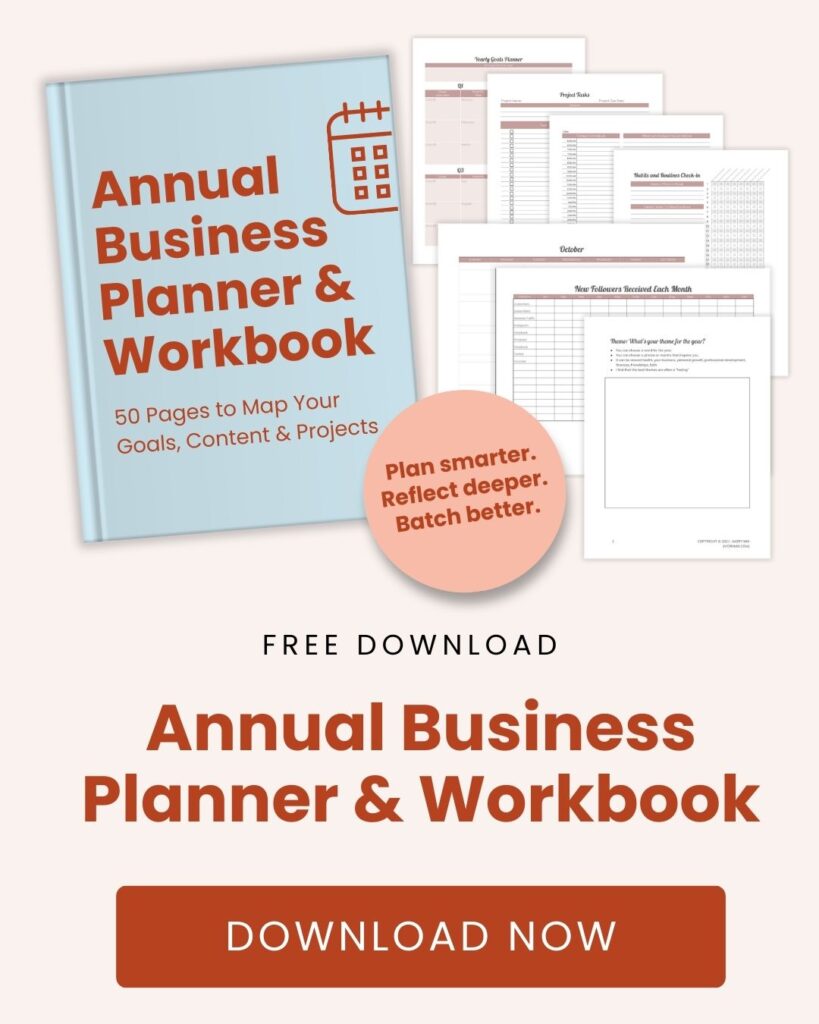









Thank you, Kayla. As usual you bring such obvious clarity to things I always struggle with. I’m still blogging after a few years where I’ve gained little traction and this year I really hope to FOCUS and be consistent. Your tools always help me get organized, it’s just me that falls off the schedule. Jessica, http://www.digitalplanningmom.com